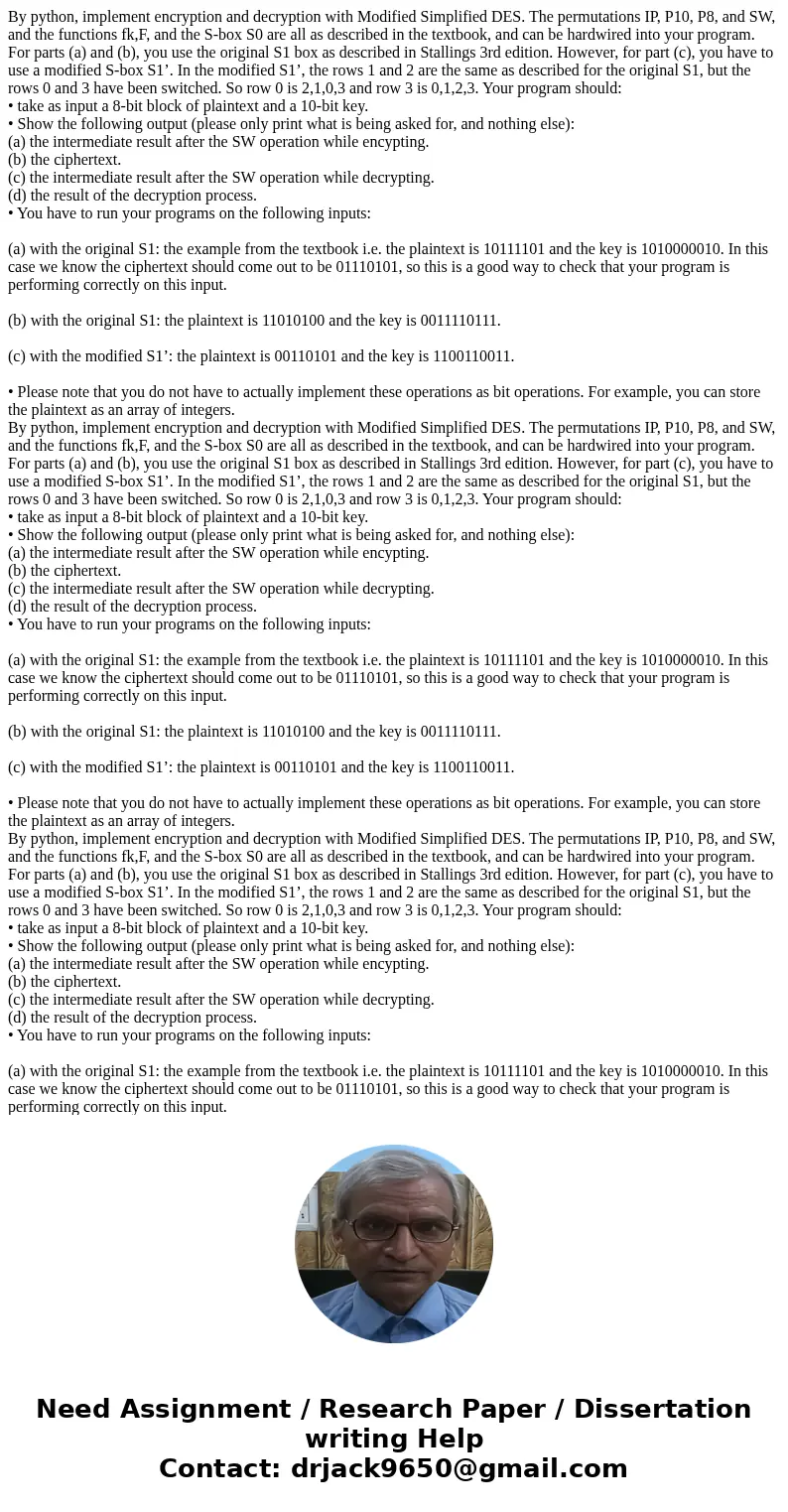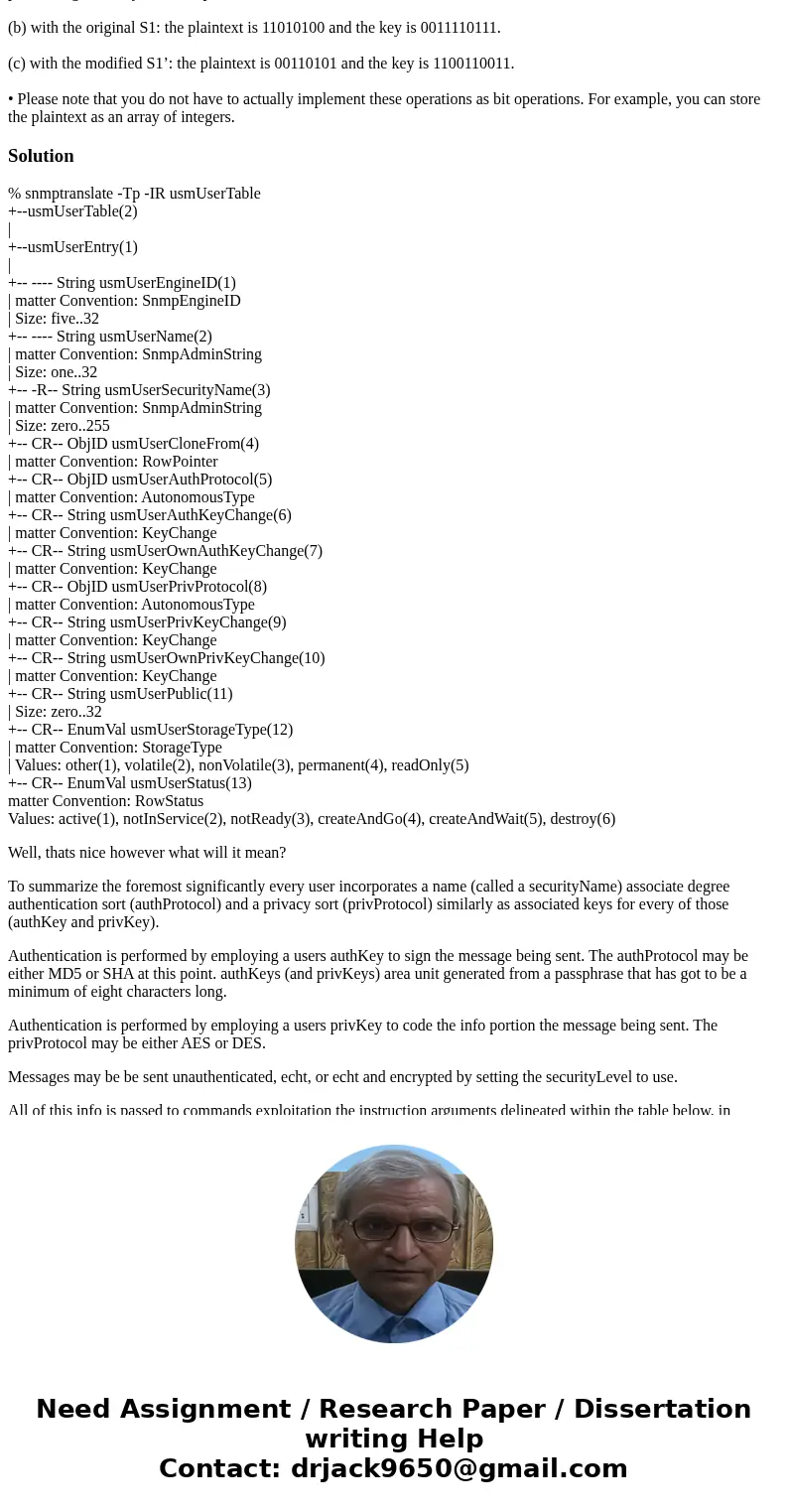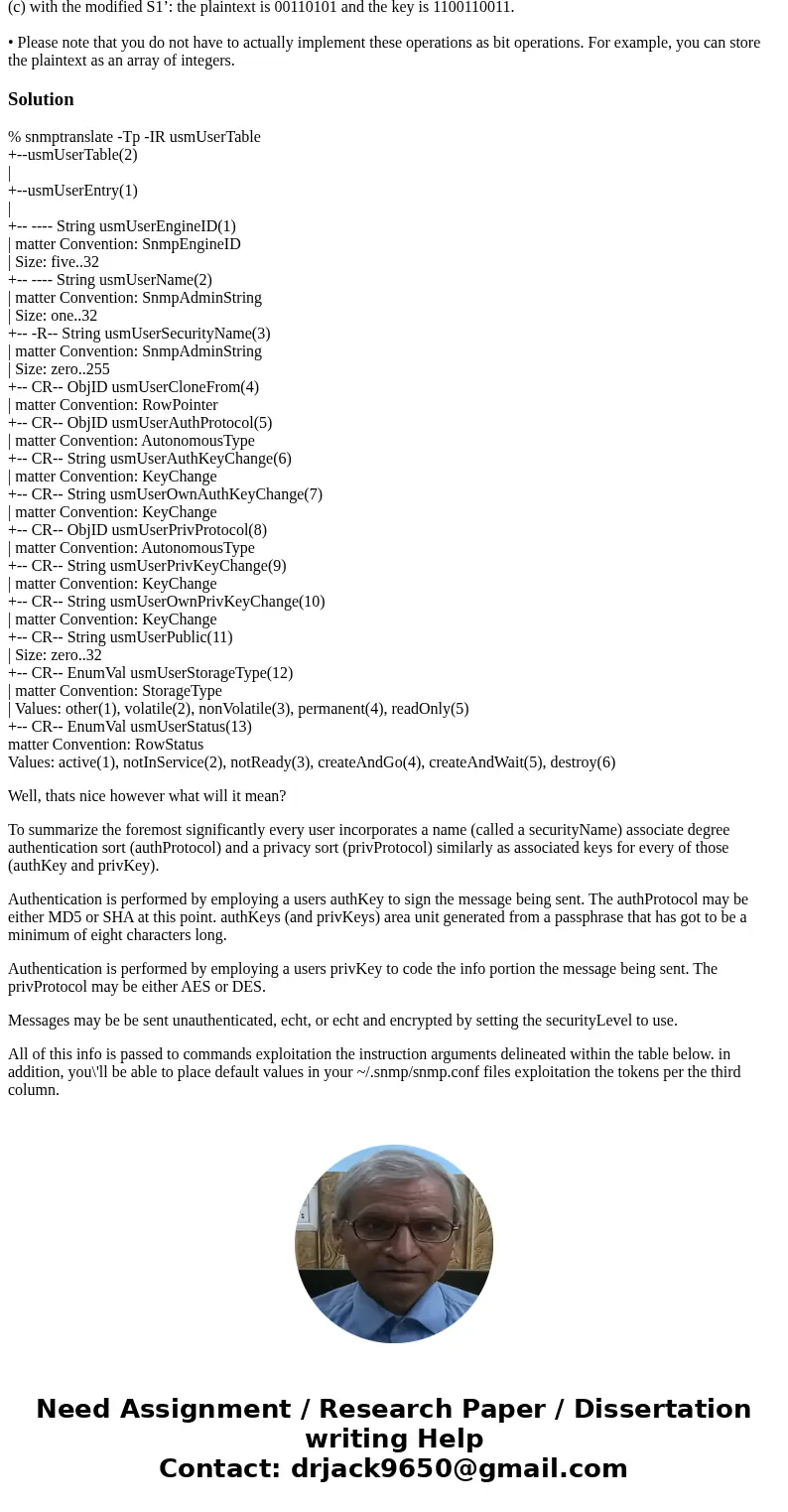By python, implement encryption and decryption with Modified Simplified DES. The permutations IP, P10, P8, and SW, and the functions fk,F, and the S-box S0 are all as described in the textbook, and can be hardwired into your program. For parts (a) and (b), you use the original S1 box as described in Stallings 3rd edition. However, for part (c), you have to use a modified S-box S1’. In the modified S1’, the rows 1 and 2 are the same as described for the original S1, but the rows 0 and 3 have been switched. So row 0 is 2,1,0,3 and row 3 is 0,1,2,3. Your program should:
• take as input a 8-bit block of plaintext and a 10-bit key.
• Show the following output (please only print what is being asked for, and nothing else):
(a) the intermediate result after the SW operation while encypting.
(b) the ciphertext.
(c) the intermediate result after the SW operation while decrypting.
(d) the result of the decryption process.
• You have to run your programs on the following inputs:
(a) with the original S1: the example from the textbook i.e. the plaintext is 10111101 and the key is 1010000010. In this case we know the ciphertext should come out to be 01110101, so this is a good way to check that your program is performing correctly on this input.
(b) with the original S1: the plaintext is 11010100 and the key is 0011110111.
(c) with the modified S1’: the plaintext is 00110101 and the key is 1100110011.
• Please note that you do not have to actually implement these operations as bit operations. For example, you can store the plaintext as an array of integers.
By python, implement encryption and decryption with Modified Simplified DES. The permutations IP, P10, P8, and SW, and the functions fk,F, and the S-box S0 are all as described in the textbook, and can be hardwired into your program. For parts (a) and (b), you use the original S1 box as described in Stallings 3rd edition. However, for part (c), you have to use a modified S-box S1’. In the modified S1’, the rows 1 and 2 are the same as described for the original S1, but the rows 0 and 3 have been switched. So row 0 is 2,1,0,3 and row 3 is 0,1,2,3. Your program should:
• take as input a 8-bit block of plaintext and a 10-bit key.
• Show the following output (please only print what is being asked for, and nothing else):
(a) the intermediate result after the SW operation while encypting.
(b) the ciphertext.
(c) the intermediate result after the SW operation while decrypting.
(d) the result of the decryption process.
• You have to run your programs on the following inputs:
(a) with the original S1: the example from the textbook i.e. the plaintext is 10111101 and the key is 1010000010. In this case we know the ciphertext should come out to be 01110101, so this is a good way to check that your program is performing correctly on this input.
(b) with the original S1: the plaintext is 11010100 and the key is 0011110111.
(c) with the modified S1’: the plaintext is 00110101 and the key is 1100110011.
• Please note that you do not have to actually implement these operations as bit operations. For example, you can store the plaintext as an array of integers.
By python, implement encryption and decryption with Modified Simplified DES. The permutations IP, P10, P8, and SW, and the functions fk,F, and the S-box S0 are all as described in the textbook, and can be hardwired into your program. For parts (a) and (b), you use the original S1 box as described in Stallings 3rd edition. However, for part (c), you have to use a modified S-box S1’. In the modified S1’, the rows 1 and 2 are the same as described for the original S1, but the rows 0 and 3 have been switched. So row 0 is 2,1,0,3 and row 3 is 0,1,2,3. Your program should:
• take as input a 8-bit block of plaintext and a 10-bit key.
• Show the following output (please only print what is being asked for, and nothing else):
(a) the intermediate result after the SW operation while encypting.
(b) the ciphertext.
(c) the intermediate result after the SW operation while decrypting.
(d) the result of the decryption process.
• You have to run your programs on the following inputs:
(a) with the original S1: the example from the textbook i.e. the plaintext is 10111101 and the key is 1010000010. In this case we know the ciphertext should come out to be 01110101, so this is a good way to check that your program is performing correctly on this input.
(b) with the original S1: the plaintext is 11010100 and the key is 0011110111.
(c) with the modified S1’: the plaintext is 00110101 and the key is 1100110011.
• Please note that you do not have to actually implement these operations as bit operations. For example, you can store the plaintext as an array of integers.
% snmptranslate -Tp -IR usmUserTable
+--usmUserTable(2)
|
+--usmUserEntry(1)
|
+-- ---- String usmUserEngineID(1)
| matter Convention: SnmpEngineID
| Size: five..32
+-- ---- String usmUserName(2)
| matter Convention: SnmpAdminString
| Size: one..32
+-- -R-- String usmUserSecurityName(3)
| matter Convention: SnmpAdminString
| Size: zero..255
+-- CR-- ObjID usmUserCloneFrom(4)
| matter Convention: RowPointer
+-- CR-- ObjID usmUserAuthProtocol(5)
| matter Convention: AutonomousType
+-- CR-- String usmUserAuthKeyChange(6)
| matter Convention: KeyChange
+-- CR-- String usmUserOwnAuthKeyChange(7)
| matter Convention: KeyChange
+-- CR-- ObjID usmUserPrivProtocol(8)
| matter Convention: AutonomousType
+-- CR-- String usmUserPrivKeyChange(9)
| matter Convention: KeyChange
+-- CR-- String usmUserOwnPrivKeyChange(10)
| matter Convention: KeyChange
+-- CR-- String usmUserPublic(11)
| Size: zero..32
+-- CR-- EnumVal usmUserStorageType(12)
| matter Convention: StorageType
| Values: other(1), volatile(2), nonVolatile(3), permanent(4), readOnly(5)
+-- CR-- EnumVal usmUserStatus(13)
matter Convention: RowStatus
Values: active(1), notInService(2), notReady(3), createAndGo(4), createAndWait(5), destroy(6)
Well, thats nice however what will it mean?
To summarize the foremost significantly every user incorporates a name (called a securityName) associate degree authentication sort (authProtocol) and a privacy sort (privProtocol) similarly as associated keys for every of those (authKey and privKey).
Authentication is performed by employing a users authKey to sign the message being sent. The authProtocol may be either MD5 or SHA at this point. authKeys (and privKeys) area unit generated from a passphrase that has got to be a minimum of eight characters long.
Authentication is performed by employing a users privKey to code the info portion the message being sent. The privProtocol may be either AES or DES.
Messages may be be sent unauthenticated, echt, or echt and encrypted by setting the securityLevel to use.
All of this info is passed to commands exploitation the instruction arguments delineated within the table below. in addition, you\'ll be able to place default values in your ~/.snmp/snmp.conf files exploitation the tokens per the third column.



 Homework Sourse
Homework Sourse